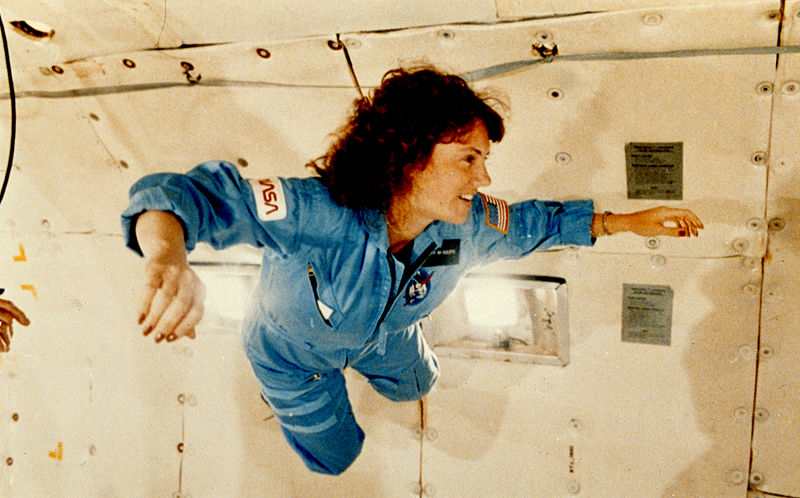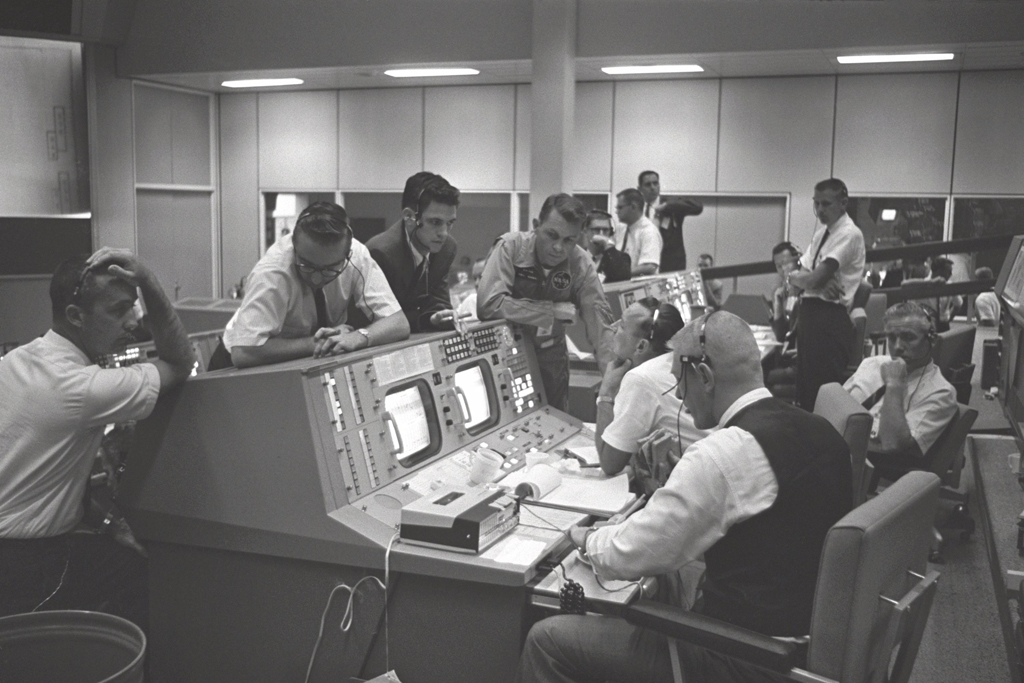January 31, 2011 Vol. 4, Issue 1
An offhand response landed Jennifer Keyes a chance to work at NASA, leading to ten years of unexpected opportunities.
“I want to be an astronaut.”
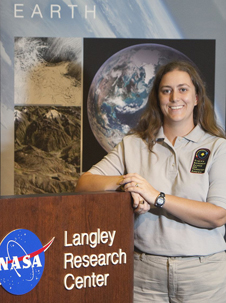
Systems analyst and systems engineer Jennifer Keyes. Photo Credit: NASA
Jennifer Keyes, a systems analyst and engineer at NASA Langley Research Center, showed all the signs of having an engineer’s mind at an early age. She took water measurements and surveyed plots of land with her father, a hydrologist. She drew out detailed assembly instructions for family campsites on vacations. She dismantled and re-assembled everything that captured her interest.
A trip to Space Camp during her senior year of high school opened her mind to the possibility of becoming an astronaut if she studied engineering. The next fall she started as a freshman at Rensselaer Polytechnic Institute (RPI), majoring in Aeronautical and Mechanical Engineering. That spring a career development counselor asked her what she wanted to be when she grew up. “Being a smart-aleck freshman,” recalled Keyes with a laugh, “I said I wanted to be an astronaut, but meanwhile, working for NASA would be cool.”
To her horror, the counselor made a few calls to contacts at NASA’s Langley Research Center. A few weeks later, she had the opportunity to apply for an internship, and wound up with her first position at NASA.
A Four-Year Interview
For her summer internship, Keyes coded for lidar data that had come back from the STS-64 Space Shuttle Discovery Lidar In-space Technology Experiment (LITE). She was given the chance create plots from data that had never been made before, “which was tremendously cool to me,” she says.
Within a matter of weeks after she finished her internship, Keyes returned for what would be the first of four co-operative (co-op) positions at Langley. During the first, she interviewed with project leads to determine which project suited her best. She chose to work on data analysis of a temperature-sensitive paint wind tunnel test with an aeronautical engineer named Ken Jones. “I started out in subsonic aerodynamics, looking at the flow of air over the airplane wings,” she says. Jones challenged her with material she had yet to learn in her aeronautics engineering classes and took the time to explain to her how the material would apply to her schoolwork.
Her co-op experiences led her into a number of fields. “There was something new and exciting to do every day,” she says. She worked in atmospheric science for a while and wrote data analysis code for an A-band spectrometer, performed systems analysis where she reviewed proposals for small spacecraft, designed “Tumbleweed” rovers for Mars, and wrote flight code for a successfully launched sounding rocket that blew off a nose cone so that the instrument could see into space.
As she neared graduation from college, a job opening at Langley in systems analysis became available. She jumped at the chance. A year earlier or a year later, she said, she might not have gotten the job. But her experience paid off. “I happened to be in the right place at the right time,” she said. “I had a four-year interview.”
Mentors and Shadowing
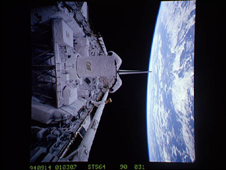
The Lidar In-space Technology Experiment (LITE) in the foreground on STS-64 Space Shuttle Discovery. Photo Credit: NASA/Johnson Space Center
Always the engineer, Keyes initially thought finding a mentor would be a data-driven process. With three prospective mentors to interview, she approached each armed with intelligent questions designed to elicit interesting answers that would guide her towards a mentor-mentee match. “That was going to be my deciding moment.”
But it wasn’t. “It was completely a gut feel,” Keyes says. Sitting in the office, of Laura O’Connor, technical assistant to the center director, she observed a different kind of data output than she had expected. “I was just sitting in her office and it just felt really natural to talk to her.” Some people want mentors who hold positions they aspire to have one day, but not everyone needs that in a mentor. “I wanted to be able to talk out hard situations.” O’Connor fit that role.
O’Connor’s mentorship led to an opportunity for Keyes to shadow Langley Center Director Lesa Roe. “I was completely amazed at her ability to have a conversation with everyone,” says Keyes. One minute Roe would be talking political strategy with a project manager, and then she’d seamlessly switch gears to have a technical discussion with a scientist. If Roe didn’t know someone, she made a point to get to know them, added Keyes. “You can tell she’s storing the information away so she knows who you are, where you came from, and how you got to where you are.”
Listen, Try Everything, and HOPE
After 10 years at NASA, Keyes has two pieces of advice for young professionals: listen and try everything. She readily admits she’s terrible with date memorization (much to the dismay of an earlier mentor, her U.S. History teacher Mr. Thomas Madson), but she appreciates learning the story behind a place, a people, and a culture.
“[History] builds the foundation for the advances in aeronautics, exploration and science that will come in later years,” Keyes once wrote in an online forum. She takes every opportunity to learn more about her center and the agency through everything from tours to participation in an archeological excavation at Langley during a construction project. But it’s the stories people share that she finds fascinating. She remembers listening to one of her colleagues talking about how cool Alan Shepard’s car was. Suddenly it dawned on her: “Holy smokes, this guy actually knew Al Shepard!”
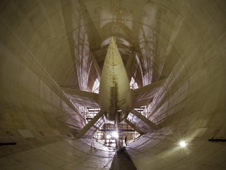
The 14 x 22 Subsonic Wind Tunnel at Langley Research Center. Photo Credit: NASA/Sean Smith
“I try to listen as much as I can,” she says. “I wish I could do a brain download on some of these guys because they’re going to leave someday, and I don’t want that [knowledge] walking out the gate with them. I don’t want it to leave in their heads and never have gotten captured.”
Trying everything leads to unexpected pieces of information or contacts that will help later on, says Keyes. A recent task involved extensive work with the international community, and now she wants to learn more about the financial side of things. “It (NASA) all runs on money, and it sure doesn’t make sense to me sometimes.” She hopes to gain a better understanding of the process of mission support and procurement to further her own experience and knowledge.
Currently, Keyes works as a systems analyst in the Constellation of Earth Observing Satellites (CEOS) office at Langley. She is also the systems engineer for DEVOTE, a project designed to develop instruments and modify two Langley research aircraft for future science missions. DEVOTE is part of Project HOPE (Hands-On Project Experience), a collaboration between the Science Mission Directorate and the Academy of Program/Project & Engineering Leadership that gives a project team the opportunity to propose, design, develop, build, and launch a suborbital flight project over the course of a year. Her team is currently finalizing its Level One requirements and success criteria for DEVOTE.
Keyes wears many hats. She tries to take advantage of every opportunity that comes her way, knowing in advance that not every one will be a perfect fit. “Some of them are a lot of work and I’ve realized they really were not the right thing for me,” says Keyes. Even with those that end up being less than enjoyable, “it’s just as important to learn that as it is to learn what you love.” Keyes also aims to strike a balance between work and life by setting realistic goals and expectations. “I’ll probably work on that for the rest of my life.”
Luck and Preparation
Keyes’s ten years at Langley happened through a series of fortunate events, from her last-minute change in college application strategy to getting a career counselor who had a connection at Langley. “I have been in the right place at the right time and surrounded by the right people ever since the very beginning,” she says.
It hasn’t been all luck. Keyes continuously prepares herself, both by trying new things and reading as much as she can. She also has developed a practice of self-reflection through journaling. A habit instilled in her during her year in NASA FIRST, she regularly writes three pages reflecting on how her day has gone.
“You can’t get to the third page without having to deal with whatever issue is going on in your head.” This ranges from finding a better way to work with someone, repairing a working relationship, or simply trying to understand fluctuations in her energy level at work.
Moving Forward
At 30 years old, Keyes hopes to have a long career ahead of her. Her initial dream of becoming an astronaut has not faded entirely. Ultimately, she wants to make a positive impact through learning from others and teaching those who come next. “I’m not sure what my path will be between here and there. I don’t know what projects or activities I’ll work on,” she says. “I like to leave my options open since I’ve already had so many opportunities, most of which I never could have planned for or guessed would happen.”






